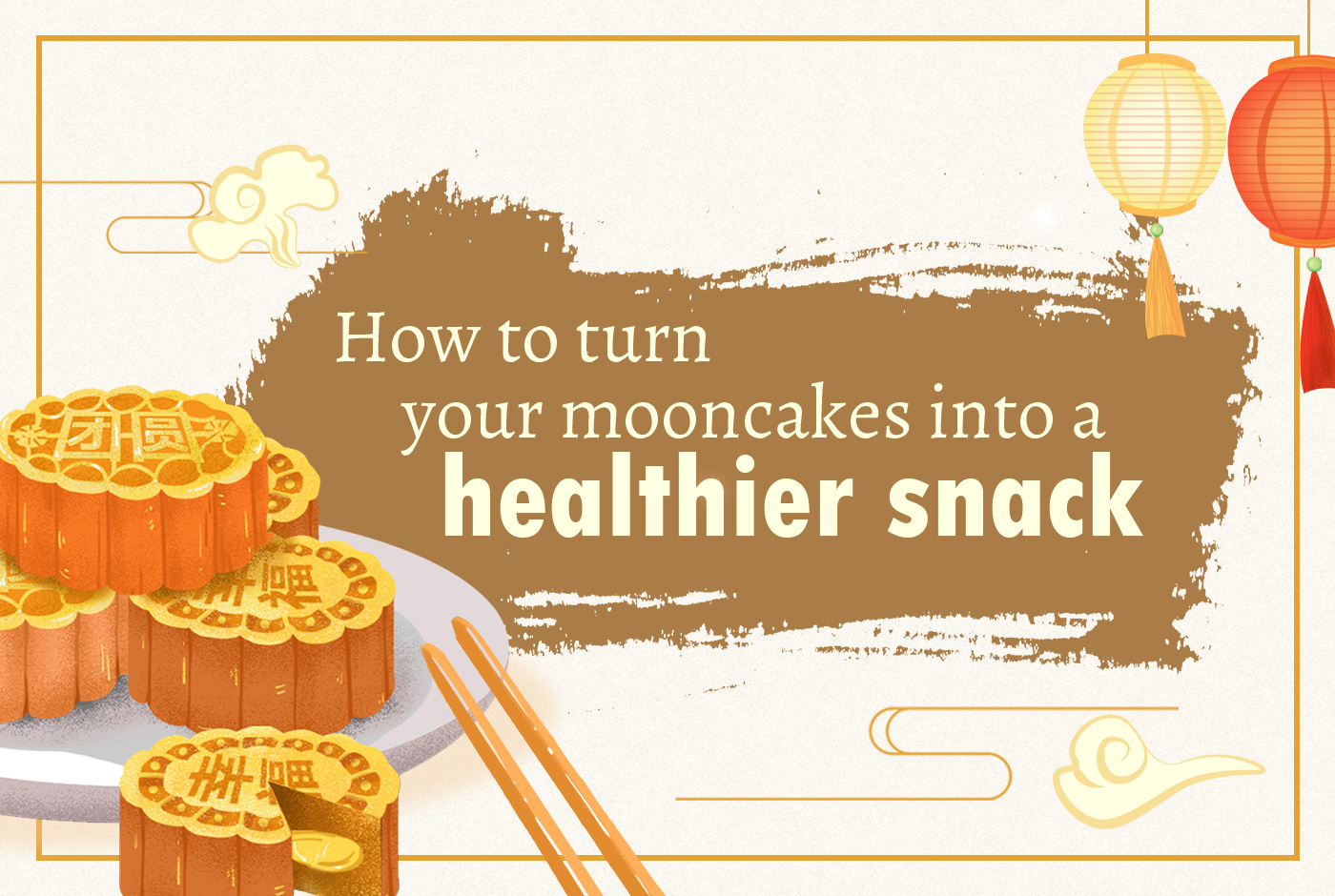How to turn your mooncakes into a healthier snack
‹ Back
 ‹ Back
‹ Back

The Mid-Autumn Festival, also known as the Mooncake Festival, is widely celebrated in most East Asian communities. It is usually celebrated with family and friends coming together to enjoy mooncakes during this festive season, while moon-gazing and lighting up lanterns.
The Mooncake Festival falls on the 15th day of the 8th month of the lunar calendar, where the moon is known to be at its fullest. In the Chinese culture, a full moon symbolises reunion and togetherness. As such, mooncakes are made to be round, and eaten together with the family as a symbol of reunion.
While mooncakes are a traditional and integral part of the celebration, they also scream caloric nightmare. According to the Singapore Heart Foundation, a traditional baked skin mooncake with lotus seed paste and 2 egg yolks is approximately 957 calories. This is already about half the median recommended daily calorie intake for an adult. To put it into perspective, it is almost equivalent to 4.5 cups of cooked rice.
Additionally, mooncakes contain a very high content of sugar. According to the World Health Organisation (WHO) guideline, the recommended daily free sugar intake should be less than 10% of your total energy intake. This calculates up to about 6 teaspoons of sugar. However, a traditional baked skin mooncake contains around 16 teaspoons of sugar! Excluding all your other meals intake, the mooncake alone is already more than twice the recommended amount of sugar for the day.
Are snow skin mooncakes healthier? This is one common misconception that snow skin mooncakes are healthier than traditional mooncakes because it is lighter and less oily. This may not be necessarily true as it is ultimately the content of the mooncake that matters. The paste may contain calories and sugar content just as high.
Fortunately, as more of us become more health aware, the trend of mooncake feasting has taken a healthier turn. There has been an increase in mooncakes of healthier choices in recent years. While mooncakes are not the healthiest food, there are also mindful ways that we can enjoy this festive snack. Here are some ways you can enjoy your mooncakes without over-compromising on your health.
If you are making your own mooncakes:
- Reduce the amount of sugar used in your mooncakes. Alternatively, you can opt out sugar altogether, and substitute it by mixing with sweet potato. You may also consider adding fruit bits to give your mooncakes a healthier sweetness.
- If you are making traditional mooncakes, choose canola, avocado or olive oil instead of using lard or butter.
- Use a multigrain flour instead of an all-purpose flour when making your mooncake crust.
- When making snow skin mooncakes, try using natural colouring from ingredients such as beetroot juice or green tea powder.
- Substitute melted chocolates with cocoa powder or 70% dark chocolate if you are thinking of making chocolate mooncakes. Cocoa powder is generally healthier compared to melted chocolate because it is lower in fat, sugar and calories.
- Make your mooncakes in a smaller size.
If you are purchasing mooncakes:
- Always read the ingredient label of the mooncakes before purchasing. The ingredients are usually listed from the highest to the lowest percentage.
- Check the shelf life of the mooncakes. The mooncakes usually contain a higher the amount of trans fat, sugar or preservatives the longer the shelf life is.
- Opt for sugar-free or low-sugar option mooncakes.
- Consider purchasing mooncakes without yolk to reduce your sodium and cholesterol intake. Alternatively, choose single yolk mooncakes instead.
When eating mooncakes:
- Control your daily calories intake by eating in small portion rather than taking one whole mooncake at once. Do not eat mooncake as a meal. Eating moderately is also a key to a healthy diet.
Fun fact: A mooncake is not supposed to be eaten wholly but cut and given into pieces equivalent to the number of members in the family. This signifies how each family member (pieces) are connected and come together as a whole.
- Do not eat your mooncake as a breakfast. Starting your day with such high sugar content may cause your blood sugar level to surge in the morning but crash later on during mid-day. This may result in you feeling more tired and craving for more sugary food. Your main meals should be well balanced with good carbohydrate, fat and protein. Drink non-sweetened Chinese, oolong or green tea along with mooncakes to help balanced out the sweetness.
Fun fact:Did you know that drinking tea is associated with having better memory. The active compound in tea called catechin might also have anti-inflammatory and anti-cancer properties.
- Reduce your carbohydrate intake for the day if you are planning to have some mooncake. Try cutting down a quarter of your rice/ noodle to prevent consuming excess carbohydrate. This is also extremely important for those with diabetes, so as to prevent a hike in blood sugar level. If you are having traditional mooncake, consider consuming less oily food to balance out as well.The most efficient way to burn off excess calories is to exercise. Ensure you also maintain a healthy lifestyle to keep your health in check.


















